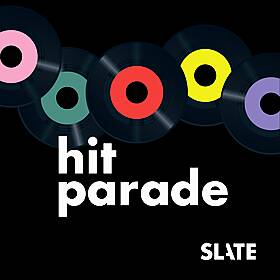
The Freewheelin’ Edition Part 2
31 January - 1 hour 2 minsAt the movies, A Complete Unknown depicts Bob Dylan as a 1960s “it” boy—played by a 2020s “it” boy, Timothée Chalamet. But the film ends in 1965. What happened in the six decades after that?
Dylan not only kept recording. He actually started topping the charts—in the 1970s, the era of Led Zeppelin, not Pete Seeger. And several of his chart-topping albums came decades later, in the 21st century. Bob’s voice got rougher, but loyal audiences kept buying his music.
Several of these platinum Dylan LPs are among the most acclaimed in rock history—from Blood on the Tracks to Time Out of Mind. And Dylan stayed an object of fascination through all his changes—as a road warrior, a born-again Christi...

Only Girl in the World Edition Part 1
It’s been nearly a decade since Rihanna released a studio album—and fans and critics alike have wondered when, if ever, a follow-up to 2016’s Anti might arrive. Which is ironic, because in her heyday, Rihanna was the most productive hitmaker on the charts. Churning out at least one album a year in the late aughts and early ‘10s, Rihanna’s approach to the charts was closer to early Motown or the Beatles than Beyoncé or Taylor. The result: the Barbadian pop deity scored more No. 1s than any 21st century artist, from “SOS” and “Umbrella” through “Diamonds” and “Work.” Join Chris Molanphy as he traces Rihanna’s journey from tropical tyro to commanding chart queen and explores how she found hits at a boundless pace. Podcast production by Kevin Bendis. Learn more about your ad choices. Visit megaphone.fm/adchoices
1 hour
11 April Finished

Singing Nuns and Green Tambourines Edition Part 2
When you think of music in the 1960s, some groundbreaking artists probably come to mind: Bob Dylan, Jimi Hendrix and the Jefferson Airplane, for example. But the pop charts paint a very different picture of that decade, which embraced easy listening, groovy bubblegum, novelty and instrumental records—even a guitar-strumming Belgian nun. In other words, the soundtrack of the era was more like Mad Men and less like Forrest Gump. Join Chris Molanphy as he unearths forgotten hits from Bobby Vinton, Kyu Sakamoto, Jeannie C. Riley, and other unlikely chart-toppers, on a still-strange trip through the ‘60s. Learn more about your ad choices. Visit megaphone.fm/adchoices
1 hour
28 March Finished

Singing Nuns and Green Tambourines Edition Part 1
When you think of music in the 1960s, some groundbreaking artists probably come to mind: Bob Dylan, Jimi Hendrix and the Jefferson Airplane, for example. But the pop charts paint a very different picture of that decade, which embraced easy listening, groovy bubblegum, novelty and instrumental records—even a guitar-strumming Belgian nun. In other words, the soundtrack of the era was more like Mad Men and less like Forrest Gump. Join Chris Molanphy as he unearths forgotten hits from Bobby Vinton, Kyu Sakamoto, Jeannie C. Riley, and other unlikely chart-toppers, on a still-strange trip through the ‘60s. Learn more about your ad choices. Visit megaphone.fm/adchoices
53 mins
14 March Finished

Singing Nuns and Green Tambourines Edition Part 1
Learn more about your ad choices. Visit megaphone.fm/adchoices
47 mins
14 March Finished

Material Girl in an Imperial World Edition Part 2
In the late 1980s, the English synth-pop duo Pet Shop Boys dominated the U.K. pop charts and staged an invasion of the American charts. Years later, founding member Neil Tennant dubbed this streak of creative and commercial supremacy the group’s “imperial phase”—a term that eventually caught on among music critics and pop fans. So, what does it take for an artist to achieve imperial dominance? Why might Fleetwood Mac in the 1970s or The Weeknd in the 2010s qualify, while Cher or Lizzo don’t quite fit the bill? Are there rules for imperial phases? Hit Parade’s Chris Molanphy says yes—he’s got chart rules for determining when an artist is at peak imperiality. And he says Madonna’s late ’80s streak of hits might be the ultimate imperial phase. Join Chris as he dissects the most regal artists across the decades, defining what makes them imperial—and he walks hit by hit through Madonna’s biggest phase, which may remain unmatched. Podcast production by Kevin Bendis. Learn more about your ad choices. Visit megaphone.fm/adchoices
46 mins
28 February Finished

Material Girl in an Imperial World Edition Part 1
In the late 1980s, the English synth-pop duo Pet Shop Boys dominated the U.K. pop charts and staged an invasion of the American charts. Years later, founding member Neil Tennant dubbed this streak of creative and commercial supremacy the group’s “imperial phase”—a term that eventually caught on among music critics and pop fans. So, what does it take for an artist to achieve imperial dominance? Why might Fleetwood Mac in the 1970s or The Weeknd in the 2010s qualify, while Cher or Lizzo don’t quite fit the bill? Are there rules for imperial phases? Hit Parade’s Chris Molanphy says yes—he’s got chart rules for determining when an artist is at peak imperiality. And he says Madonna’s late ’80s streak of hits might be the ultimate imperial phase. Join Chris as he dissects the most regal artists across the decades, defining what makes them imperial—and he walks hit by hit through Madonna’s biggest phase, which may remain unmatched. Podcast production by Kevin Bendis. Learn more about your ad choices. Visit megaphone.fm/adchoices
1 hour 7 mins
14 February Finished





















